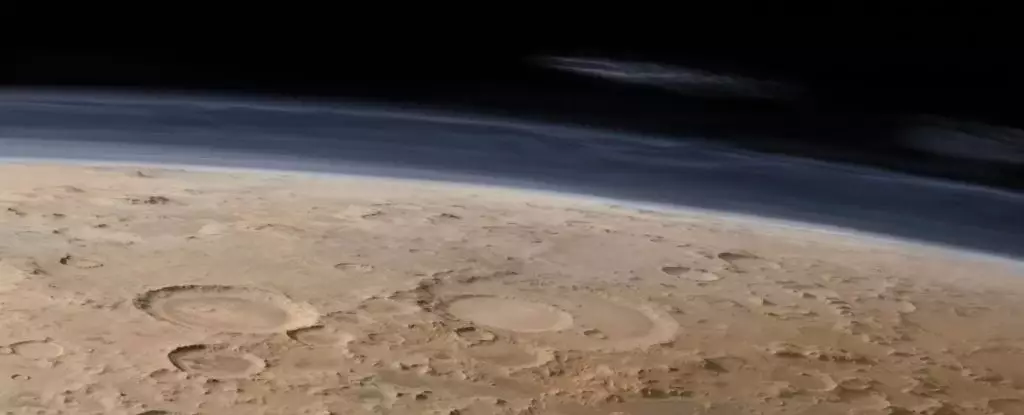In an astronomical revelation that reshapes our understanding of the Martian atmosphere, scientists have successfully identified the phenomenon of atmospheric sputtering for the first time. After meticulously analyzing more than nine years of satellite data, a team led by Shannon Curry from the University of Colorado Boulder has made groundbreaking strides in comprehending how Mars has lost both its atmosphere and vital water resources. Their findings not only underscore the importance of atmospheric sputtering in the planet’s past but also highlight larger implications for planetary habitability within our Solar System.
Atmospheric sputtering is a complex but fascinating process that occurs when energetic ions, propelled by the solar wind, collide with atmospheric particles, contributing to the gradual loss of an atmosphere. Such findings shed light on the Mars of yesteryear—an unsheltered planet that once basked in the relentless glare of a much more active young Sun.
The Mechanics of Atmospheric Sputtering
Understanding atmospheric sputtering requires a grasp of its mechanics and the unique environmental conditions that allow it to occur. Mars, with its minimal magnetic protection, is particularly vulnerable to these cosmic forces. The solar wind acts as a relentless bombardier, flinging high-energy ions toward the Martian surface. When these ions collide with the atmosphere, they impart enough energy to certain atmospheric particles, propelling them into space at velocities that exceed the escape threshold.
This phenomenon resembles the effects of meteoric impacts on planetary surfaces, yet the subtlety lies in the scale and consistency of the sputtering process. While impacts create momentary bursts of intense energy, sputtering represents a continuous and gradual atmospheric erosion that can significantly alter a planet’s climate and habitability over eons.
The Role of NASA’s MAVEN Mission
To observe such nuanced dynamics, researchers relied heavily on data from NASA’s MAVEN (Mars Atmosphere and Volatile Evolution) mission, which has been orbiting Mars since September 2014. MAVEN is equipped with specialized instruments capable of simultaneous observations essential for understanding the interplay between solar excitation and atmospheric loss. This unique capability allows scientists to study how variations in the solar wind impact Martian atmospheric density, particularly focusing on isotopes of argon—key indicators of the sputtering effect.
Through an in-depth analysis of argon densities above an altitude of 350 kilometers, the researchers discovered crucial discrepancies between lighter and heavier isotopes. This finding suggests a direct link to active sputtering, as the lighter isotopes were more readily expelled from the atmosphere, leaving a higher concentration of heavier argon behind. Such insights are vital for piecing together the climatic history of Mars, revealing not just a narrative of loss and depletion, but also of past environmental conditions.
Solar Storms: A Catalyst for Change
The stakes of this investigation have only heightened with the discovery of significant sputtering activity correlated with solar storms. Observations recorded during a solar storm in January 2016 unveiled strong evidence that atmospheric sputtering can be substantially amplified under tumultuous solar conditions, leading to a sputtered yield over four times higher than previously predicted. This assertion not only reinforces the role of solar forces in atmospheric erosion but also paints a vivid picture of ancient Martian landscapes during a more dynamic phase of the Solar System’s evolution.
By linking sputtering rates to specific solar activity, researchers are beginning to construct a clearer timeline of Mars’s atmospheric changes, uncovering how solar activity shaped the environment millions of years ago. Future implications of these findings could influence our search for life beyond Earth, as scientists strive to define the parameters of habitability across different planetary bodies.
Implications for Our Understanding of Planetary Development
The investigation into Mars’s atmospheric sputtering is not merely an academic exercise; it poses significant ramifications for our understanding of planetary development and the potential for life beyond Earth. If sputtering played a critical role in shaping Mars’s atmosphere, then similar mechanisms may apply to other celestial bodies lacking robust magnetic fields. This could expand our search parameters for habitable environments in the cosmos, as we consider factors beyond just water presence and surface conditions.
As scientists continue to decode the complexities of atmospheric dynamics, the echoes of their discoveries will resonate through our ongoing exploration of the universe. The mysteries held by planets like Mars may indeed offer us glimpses into broader processes that govern planetary habitability, urging humanity to reflect on our place within this vast, ever-evolving cosmic landscape.


Leave a Reply